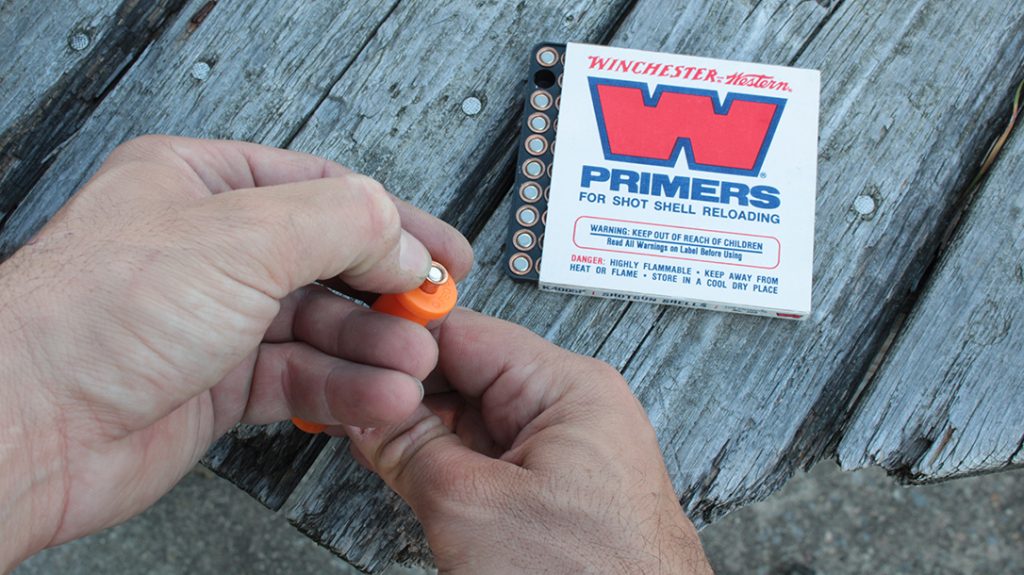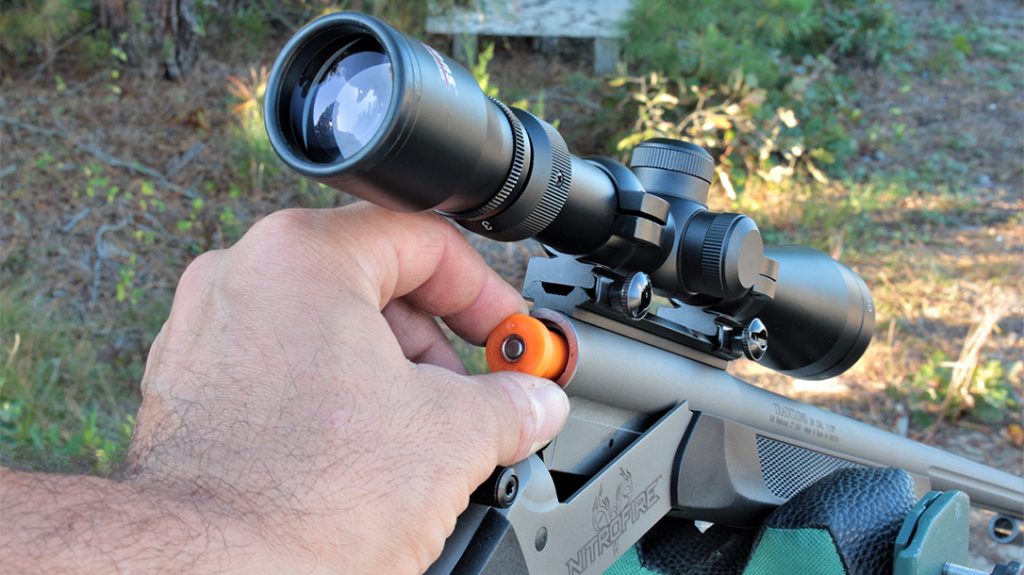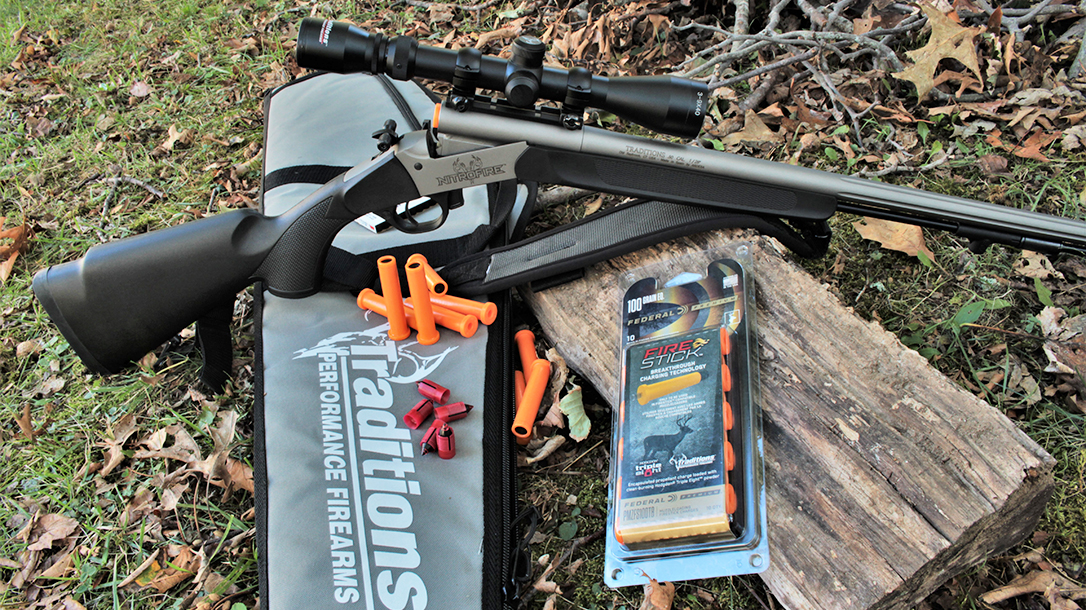Before we get to what Traditions and Federal Premium have done with the NitroFire and Firestick, let’s look at why they’re both game changers. Every year all over the country we hear the same back and forth quips wherever hunters gather. One hunter makes a qualm about how short deer season is only to be met with the retort from another that they should “get into muzzleloading.”
Many folks shy away from this notion because it departs very far from the norm of the firearms kingdom. Front-stuffers require an entirely new skillset, not to mention tools and the investment of time both on and off of the range. That, and many people find the entire experience, well, scary. Truth be told, I reloaded high-pressure brass cartridges before I ever fathomed the thought of pouring black powder down a pipe and backing a piece of lead up against it.
So what’s a guy with a busy schedule to do? Something new just needed to be invented, and no one company alone had stepped up to the plate. Well, the best inventions require the teamwork of two businesses; think peanut butter & chocolate, or hookers & blow … eh, maybe not that second one. But this new collaboration involves Federal Ammunition and Traditions Firearms. Their creation is the FireStick-fueled NitroFire muzzleloader.
Advertisement — Continue Reading Below
OK, lots of questions here: Is this thing considered a modern firearm? Is Amazon going to sue for the use of the word “stick”? Does it need Wi-Fi?! To get my answers I went where I always go, the gun shop.
What Is the Traditions NitroFire?
The best way to start describing this new system is to look at the gun itself. The Traditions NitroFire is a hinge-action that is part breechloader and part muzzleloader. While the projectile is rammed down the muzzle, the self-contained powder cartridge (the FireStick) is inserted into the breech.

Advertisement — Continue Reading Below
Being that it “sort of” loads like a conventional weapon, Traditions yielded to the ATF and just went with the modern firearm ruling to get it to the market faster. In this writer’s opinion, it wouldn’t surprise me if the ATF changes its mind after it gets a little pushback from the hunting community; let’s just hope enough folks get involved.
So to get your hands on one it needs to be shipped to a gun store and you will need to get your background check done. However, in the eyes of most state DEC offices it is still a muzzleloader and therefore can be used during muzzleloader season or even during rifle season if you enjoy shooting it as much as I do; just check with your state first.
To the Breech
Now, as sleek-looking as the gun was, the story doesn’t get going until you look at the charging component, the Federal FireStick. Working with black powder can be messy and maybe even a little dangerous if you don’t pay close attention to what you’re doing. Furthermore, dealing with it in the elements isn’t exactly an exercise in reliability. The FireStick changes all of that by wrapping up either 100 or 120 grains of Hodgdon Triple Eight powder into a fully encapsulated cartridge that is set off by a 209 muzzleloader or shotshell primer.
Advertisement — Continue Reading Below
Best of all, to load it you just slip it into the breech after you’ve sat a bullet, and once you insert a primer it’s ready to go. If you have a bad (or my typical) day and don’t see anything to shoot, just unload the gun the same way you would a break-action shotgun and push the bullet out of the muzzle with your ramrod.
No more doing a desk pop to safely get out of your tree stand and then cleaning your gun for absolutely no reason when you get home! Being that the primer doesn’t break the seal on the FireStick until it ignites, both it and the FireStick are completely reusable. Just toss that mangled bullet … you cheap bastard.

Advertisement — Continue Reading Below
With rifle in hand, I went with Tradition’s 250-grain .50-caliber Carnivore bullets. The nice thing about these is that they sit in a self-lubricating ridgeback sabot; that way no patches or lube are necessary between shots.
Before seating a bullet, I opened ’er up and peeked through the breech down at my target. I wanted to see if the pre-mounted scope was close enough to get on paper. To my delight, it appeared to be previously bore-sighted, so I continued.
Testing the Traditions NitroFire
The first portion of the firing experience that I took note of was the seating of the bullet itself. Unlike conventional muzzleloaders, there wasn’t any guesswork as to when to stop. When I got to the bottom of the barrel I heard a very definitive “CLUNK” as the bullet contacted the shelf before the chamber. This is a reference point for seating. It’s also a convenient little feature that keeps you from going too far.
Advertisement — Continue Reading Below
Everything needed to load the gun came with the rifle. Traditions attached it under the barrel, just like in the old days. A bullet starter made the process a little easier, but it isn’t necessary if you are a minimalist. Once the bullet seated, I prepared a FireStick with a primer, inserted it, closed the action, and cocked the hammer. From there, I was in business.
From a bench rest position, I aimed at a Birchwood Casey Shoot-N-C target that I placed 50 yards away. Then I let it rip. My first shot impacted at the 12 o’clock position. If the target had fur it would have been flat on the ground.

Advertisement — Continue Reading Below
One might expect a foul smell from the discharge, like some sort of mix between rotten eggs and burning plastic. However, ironically, there wasn’t much scent to speak of and the little bit there was wasn’t that unpleasant. It was pretty much just like any other gun smoke but just a hair sweeter. Reloading took me less than 30 seconds from start to finish. In no time I was through my first 10 shots without a single cleaning.
Range Results
As my range day went on I took some time to gather velocities via a MagnetoSpeed V3 chronograph. I was quite impressed that these things were flying at an average velocity of 2,016 fps; that’s a lot of heat coming off a 250-grain bullet. Furthermore, the standard deviation of a five-shot group was only 23 fps; that’s as consistent as most cartridge ammunition that I’ve tested in my career.
Numbers are nice, but the clincher for me was the five-shot group that nearly touched; it measured a scant 1.7 inches from center to center. I mean what else would you expect? It’s the same amount of powder, being ignited the same way, pushing the same bullet, with the same wadding, from the same place every time. Consistency at the firing line equals consistency at the target, period.
Advertisement — Continue Reading Below
Using the Traditions NitroFire
Ownership of the NitroFire is pretty easy too. For starters, it’s a completely open system. Not sure if you stuck a bullet in? Just crack it open and see if you can see light. Not a whole lot of mechanical inclination is necessary either. Disassembly is as simple as removing one solemn screw and slipping off the forend and the barrel.
It isn’t explicitly in the works yet, but I can see alternative barrels being offered in the future. It would allow shooters to change calibers and maybe even retrofit their NitroFire to take traditional black powder charges and percussion caps, should they want to save their FireSticks for the field.

Advertisement — Continue Reading Below
The completely open system simplified another element too: Cleaning. When I finished my range day, I pulled the barrel and just swabbed it with good ole-fashioned soap and water. Then I sent a few pre-saturated Blackout 209 cleaning patches through it to ensure I removed any remaining corrosive residue. I dried, oiled, and reassembled the gun in about 25 minutes without my wife ever finding out what I did to her bathtub.
Before You Blast
While the Traditions NitroFire might be shunned by the purists who prefer to do things the old-fashioned way, it is an absolute godsend for people like me who want to spend more time pursuing game, but just don’t have the time to hone their black powder skills. With the FireStick cartridges, this becomes the ultimate way to introduce somebody to the sport of muzzleloading. It should even open their eyes to how easy it can be. For even more info, please visit FederalPremium.com or TraditionsFirearms.com.























